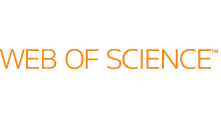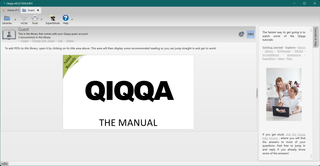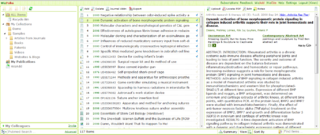
BibTeX is reference management software for formatting lists of references. The BibTeX tool is typically used together with the LaTeX document preparation system. Within the typesetting system, its name is styled as . The name is a portmanteau of the word bibliography and the name of the TeX typesetting software.
Reference management software, citation management software, or bibliographic management software is software that stores a database of bibliographic records and produces bibliographic citations (references) for those records, needed in scholarly research. Once a record has been stored, it can be used time and again in generating bibliographies, such as lists of references in scholarly books and articles. Modern reference management applications can usually be integrated with word processors so that a reference list in one of the many different bibliographic formats required by publishers and scholarly journals is produced automatically as an article is written, reducing the risk that a cited source is not included in the reference list. They will also have a facility for importing bibliographic records from bibliographic databases.
Reference Manager was the first commercial reference management software package sold by Thomson Reuters. It was the first commercial software of its kind, originally developed by Ernest Beutler and his son, Earl Beutler, in 1982 through their company Research Information Systems. Offered for the CP/M operating system, it was ported to DOS and then Microsoft Windows and later the Apple Macintosh. Research Information Systems was acquired by Thomson Business Information in 1994. Subsequently, Thomson acquired EndNote and ProCite, the other two leading bibliographic management programs. Rich Niles, founder of EndNote, joined Thomson Reuters as head of that division, and put all development focus on EndNote. Sales of Reference Manager continued until December 31, 2015, and support ended on December 31, 2016.
RIS is a standardized tag format developed by Research Information Systems, Incorporated to enable citation programs to exchange data. It is supported by a number of reference managers. Many digital libraries, like IEEE Xplore, Scopus, the ACM Portal, Scopemed, ScienceDirect, SpringerLink, Rayyan, Accordance Bible Software, and online library catalogs can export citations in this format. Citation management applications can export and import citations in this format.

Zotero is a free and open-source reference management software to manage bibliographic data and related research materials, such as PDF files. Features include web browser integration, online syncing, generation of in-text citations, footnotes, and bibliographies, an integrated PDF reader and note editor, as well as integration with the word processors Microsoft Word, LibreOffice Writer, and Google Docs. It was originally created at the Center for History and New Media at George Mason University and, as of 2021, is developed by the non-profit Corporation for Digital Scholarship.
ContextObjects in Spans (COinS) is a method to embed bibliographic metadata in the HTML code of web pages. This allows bibliographic software to publish machine-readable bibliographic items and client reference management software to retrieve bibliographic metadata. The metadata can also be sent to an OpenURL resolver. This allows, for instance, searching for a copy of a book at a specific library.
The following tables compare notable reference management software. The comparison includes older applications that may no longer be supported, as well as actively-maintained software.
The Citation Style Language (CSL) is an open XML file format that describes schema for the formatting of citations and bibliographies. Reference management programs using CSL include Zotero, Mendeley and Papers. The Pandoc lightweight document conversion system also supports citations in CSL, YAML, and JSON formats and can render these using any of the CSL styles listed in the Zotero Style Repository.

BibDesk is an open-source reference management software package for macOS, used to manage bibliographies and references when writing essays and articles. It can also be used to organize and maintain a library of documents in PDF format and other formats. It is primarily a BibTeX front-end for use with LaTeX, but also offers external bibliographic database connectivity for importing, a variety of means for exporting, and capability for linking to local documents and automatically filing local documents. It takes advantage of many macOS features such as AppleScript and Spotlight.
The Derwent World Patents Index (DWPI) is a database containing patent applications and grants from 44 of the world's patent issuing authorities.

The Web of Science is a paid-access platform that provides access to multiple databases that provide reference and citation data from academic journals, conference proceedings, and other documents in various academic disciplines. Until 1997, it was originally produced by the Institute for Scientific Information. It is currently owned by Clarivate.
Scholar's Aid is a shareware reference management software package. The project seems to idle. There have been no updates since September 2010.
ResearcherID is an identifying system for scientific authors. The system was introduced in January 2008 by Thomson Reuters Corporation.

Qiqqa is a free and open-source software that allows researchers to work with thousands of PDFs. It combines PDF reference management tools, a citation manager, and a mind map brainstorming tool. It integrates with Microsoft Word XP, 2003, 2007 and 2010 and BibTeX/LaTeX to automatically produce citations and bibliographies in thousands of styles.

WizFolio was a web-based reference management software for researchers to manage, share their research and academic papers and generate citations in scholarly writings. It used plug-ins to collect bibliographic information, videos, and patents from webpages. WizFolio ceased to be available at the end of 2017.
Nota Bene is an integrated software suite of applications, including word processing, reference management, and document text analysis software that is focused on writers and scholars in the Humanities, Social Sciences, and the Arts. The integrated suite is referred to as the Nota Bene Workstation. It runs on Microsoft Windows and Macintosh.

Citavi is a program for reference management and knowledge organization for Microsoft Windows published by Swiss Academic Software in Wädenswil, Switzerland. Citavi is very widely used in Germany, Austria, and Switzerland, with site licenses at most universities, many of which offer training sessions and settings files for Citavi.
ProCite, a commercial reference management software program, was designed in the early 1980s by Victor Rosenberg, associate professor in the School of Library and Information Studies at the University of Michigan, Ann Arbor. ProCite was published in 1983 by Personal Bibliographic Software of Ann Arbor, Michigan. In 1996, ProCite was purchased by the Institute for Scientific Information, a division of Thomson Reuters. Thomson Reuters discontinued sales and support of Procite in May 2013.

Zim is a graphical text editor designed to maintain a collection of locally stored wiki-pages, a personal wiki. Each wiki-page can contain things like text with simple formatting, links to other pages, attachments, and images. Additional plugins, such as an equation editor and spell-checker, are also available. The wiki-pages are stored in a folder structure in plain text files with wiki formatting. Zim can be used with the Getting Things Done method.

Paperpile is a web-based commercial reference management software, with special emphasis on integration with Google Docs and Google Scholar. Parts of Paperpile are implemented as a Google Chrome browser extension. It was founded in 2012, and is produced by Paperpile LLC.








